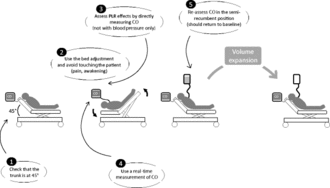Medicine:Passive leg raising test
| Passive leg raising test | |
|---|---|
| Medical diagnostics | |
 |
In medicine, the passive leg raising test is a bedside test to evaluate the need for further fluid resuscitation in critically ill patients.[1]
This test involves raising the legs of a patient (without their active participation), which causes gravity to pull blood from the legs, thus increasing circulatory volume available to the heart (cardiac preload) by around 150-300 milliliters, depending on the amount of venous reservoir.[1] The real-time effects of this maneuver on hemodynamic parameters such as blood pressure and heart rate are used to guide the decision whether or not more fluid will be beneficial.[2][3] The assessment is easier when invasive monitoring is present (such as an arterial catheter).
The maneuver might be reinforced in a clinical setting by moving the patient's bed from a semi-recumbent position to a recumbent position with the legs raised. This is theorised to cause an additional mobilisation of blood from the gastrointestinal circulation.[4][5] Direct measurement of cardiac output is the more reliable comparing to the measurement of blood pressure or pulse pressure because of pulse pressure amplification during this procedure. Cardiac output can be measured by arterial pulse contour analysis, echocardiography, esophageal Doppler, or contour analysis of the volume clamp-derived arterial pressure. Any bronchial secretions must be aspirated before performing this test. The legs should not be elevated manually because it may provoke pain, discomfort, or awakening that can cause adrenergic stimulation, giving false readings of cardiac output by increasing heart rate. After the maneuver, the bed should be placed back into semi-recumbent position with cardiac output measured again. The cardiac output should return to the values measured before the initiation of this maneuver. This test can be can used to access fluid responsiveness without any fluid challenge, where the latter can lead to fluid overload.[6] Compression stockings should be removed before the test so that adequate volume of blood will return to the right heart during the maneuver.[7] The physiology of assessing fluid responsiveness via passive leg raise requires increasing systemic venous return without altering cardiac function - a form of functional hemodynamic monitoring.[8]
Several studies showed that this measure is a better predictor of response to rapid fluid loading than other tests such as respiratory variation in pulse pressure or echocardiographic markers.[8]
References
- ↑ 1.0 1.1 "Passive leg raising". Intensive Care Med 34 (4): 659–63. April 2008. doi:10.1007/s00134-008-0994-y. PMID 18214429.
- ↑ "Changes in BP induced by passive leg raising predict response to fluid loading in critically ill patients". Chest 121 (4): 1245–52. April 2002. doi:10.1378/chest.121.4.1245. PMID 11948060. http://www.chestjournal.org/cgi/pmidlookup?view=long&pmid=11948060.
- ↑ "Diagnosis of central hypovolemia by using passive leg raising". Intensive Care Med 33 (7): 1133–8. July 2007. doi:10.1007/s00134-007-0642-y. PMID 17508202.
- ↑ "Passive leg raising for predicting fluid responsiveness: importance of the postural change". Intensive Care Med 35 (1): 85–90. September 2008. doi:10.1007/s00134-008-1293-3. PMID 18795254.
- ↑ "Prediction of volume responsiveness in critically ill patients with spontaneous breathing activity". Curr Opin Crit Care 14 (3): 334–9. June 2008. doi:10.1097/MCC.0b013e3282fd6e1e. PMID 18467896.
- ↑ Xavier, Monnet (14 January 2015). "Passive leg raising: five rules, not a drop of fluid!". Critical Care 19 (18): 237. doi:10.1186/s13054-014-0708-5.
- ↑ Jacob Chakco, Cyril; P Wise, Matt; J Frost, Paul (1 June 2015). "Passive leg raising and compression stockings: a note of caution". Critical Care 19 (237). doi:10.1186/s13054-015-0955-0.
- ↑ 8.0 8.1 Monnet, X; Marik, PE; Teboul, JL (December 2016). "Prediction of fluid responsiveness: an update.". Annals of intensive care 6 (1): 111. doi:10.1186/s13613-016-0216-7. PMID 27858374.
See also

